
Trying to make a career change, Help me please. I've been applying to everything I can, mostly just simple help desk positions and I can't get an interview. What is wrong with this resume?
Thinking about switching careers? You're not alone—and you're definitely not crazy.
Making a career change can feel like stepping off a cliff without a parachute. Whether you're moving into a completely different industry or pivoting your role, it’s normal to feel overwhelmed. You might even feel like you're starting from scratch, competing against professionals who’ve spent years in the field.
Sounds intimidating, right?
But here’s the good news: with a well-crafted career change resume, that leap doesn’t have to feel so risky.
In fact, the right resume can highlight your transferable skills, showcase your adaptability, and position you as a valuable asset—even in a new profession. A strategic approach to your resume can be the difference between getting overlooked and getting hired.
Not sure where to start? You’re in the right place. If you’re starting to put together your career change resume, you might find it helpful to use a simple, customizable Google Docs resume template to organize your information clearly.
In this guide, we’ll walk you through everything you need to know about building a resume for a career transition—from formatting tips to powerful examples that work.
Let’s turn uncertainty into opportunity. And if you're entering a new industry without direct experience, our no experience resume summary examples can guide your writing.
Choosing the Best Career Change Resume Format
One of the most important steps in crafting an effective career change resume is choosing the right format—one that tells your story clearly and convincingly.
When you're transitioning into a new industry, your resume needs to highlight your transferable skills, downplay irrelevant experience, and frame your past in a way that aligns with your future goals.
That’s exactly why the combination resume format (also known as the hybrid resume) is ideal for career changers.
Why the Combination Format Works for Career Transitions
Unlike the traditional chronological format—which emphasizes your work history—or the functional format—which focuses almost entirely on skills, the combination resume strikes a balance. It gives equal weight to your skills and your professional background, making it the perfect fit when:
- You’re making a career shift and want to showcase relevant skills even if you don’t have a matching job title
- You have employment gaps or non-linear work experience
- You bring a diverse skill set across different industries
- You’re applying to both creative roles (like design or marketing) and traditional positions (like finance or HR)
In short, the combination format helps hiring managers focus on what you can do, not just where you've been.
What to Include in a Career Change Resume Using the Combination Format
To make the most of this format, structure your resume in the following order:
1. Contact Information
2. Resume Objective or Summary
- Tailor it to reflect your career pivot and highlight your enthusiasm for the new field.
3. Skills Summary
- Focus on transferable skills that match the new job’s requirements.
4. Work Experience
- Emphasize accomplishments and duties that relate to your target industry.
5. Education
6. Certifications
- Include any new qualifications or training relevant to your career change.
7. Projects or Portfolio Work
- Great for demonstrating applied skills in a new domain—even if unpaid or self-initiated.
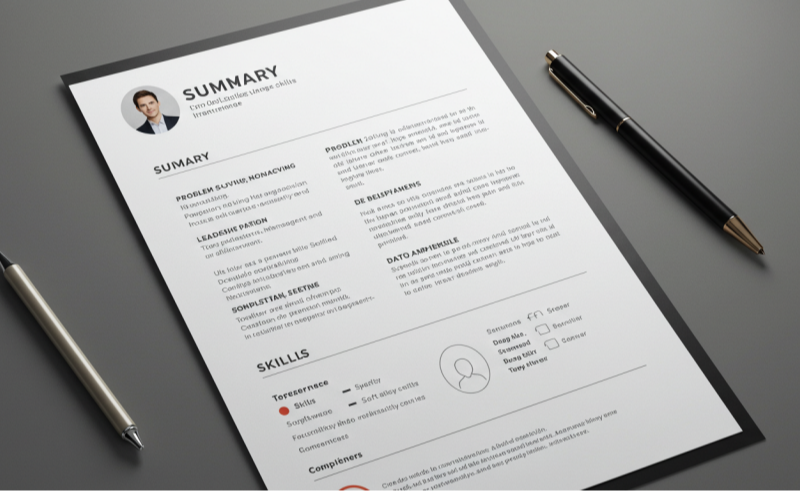
How to Add Contact Information to Your Career Change Resume
Let’s be honest—no matter how polished your career change resume is, it won’t land you a callback if the hiring manager can’t reach you.
That’s why your contact information is arguably the most critical part of your resume. It’s often the first thing recruiters look at, and any mistakes here can cost you the opportunity—no matter how qualified you are.
What to Include in the Contact Info Section
Here’s a quick checklist to make sure your contact details are professional, complete, and error-free:
- Full Name: Use your first and last name. Avoid nicknames or overly casual variations.
- Phone Number: Include your country code if you’re applying internationally (e.g., +1 for the U.S.). Make sure your voicemail is appropriate, too.
- Professional Email Address: Stick to a clean, professional format like firstname.lastname@gmail.com. Avoid anything like soccerqueen92@....
- Location: City and state or city and country are enough (e.g., Austin, TX or Toronto, Canada). This helps recruiters understand whether relocation or remote arrangements are needed.
- Job Title: Either list your current role or the desired job title—ideally the exact title from the job posting. This helps tailor your resume at a glance.
- Online Portfolio or Profile (Optional but Recommended): If you’re transitioning into a digital or creative field, include links to your:
- LinkedIn profile
- GitHub (for developers)
- Medium (for writers)
- Portfolio website or Behance (for designers)

PRO TIP
Triple-check for typos. A simple typo in your email or phone number could mean a missed interview. Always double-check your contact info before submitting your resume.
Get Powerful Career Change Resume Objective or Summary
You’ve nailed your contact information—great start.
Now comes a crucial moment: giving the hiring manager a reason to keep reading.
Considering recruiters spend just six seconds scanning a resume, your opening statement needs to instantly capture attention. That’s where a well-written resume objective or summary can make all the difference—especially on a career change resume.
These short sections sit at the top of your resume and serve as a quick snapshot of who you are, what you bring to the table, and why you're a strong fit for the role—even if you're changing professions.
Career Change Resume Objective vs. Summary: What’s the Difference?
When writing a career change resume, your goal is to help hiring managers quickly understand how your existing skills and experience translate into value for a new role—even if your job titles don’t align perfectly.
That’s where a strong resume summary or objective comes in. These brief sections, placed at the top of your resume, instantly highlight your potential and make the case for why you're a great fit despite coming from a different industry.
Resume Summary
A resume summary is ideal if you’ve worked in a related field and have clear, transferable accomplishments to showcase. It highlights your most relevant experience and skills, helping bridge the gap between your past role and your new target industry.
Resume Objective
A resume objective is a better fit if you're pivoting from an unrelated field and want to emphasize your career goals and motivation, as well as how your current skills can apply to the new role.

QUICK TIP
If you’re not sure which one to use, go with a summary when you can draw parallels between your old and new roles. Stick with an objective when the connection isn’t as obvious.
Example of a Career Change Resume Summary

Example
Resume Summary:
Transitioning from Customer Support to Sales
Customer support specialist with 4+ years of experience providing high-quality technical assistance over the phone. Known for clear communication, problem-solving under pressure, and consistently earning a 4.6/5 customer satisfaction rating over the past 2 years. Seeking to apply interpersonal and persuasion skills in a Sales Agent role at Company XYZ.
Why it works: This summary quickly establishes the candidate’s strengths, provides measurable results, and shows how their transferable skills—like communication and problem-solving—are relevant to the new field (sales).
Example of a Career Change Resume Objective

Example
Resume Objective:
Shifting to Marketing Without Prior Experience
Organized and self-motivated professional aiming to join XYZ as a Marketing Assistant. Brings hands-on experience with Photoshop, graphic design, and creative copywriting from freelance and academic projects. Eager to support XYZ’s marketing efforts while growing in a fast-paced, creative environment.
Why it works: Even without direct experience, this resume objective for a career change focuses on relevant skills and shows a clear desire to grow in the new field. It helps the employer see the candidate's potential and motivation.
Tips for Writing Your Career Change Resume Summary or Objective
Crafting a compelling career change resume summary or objective is all about making connections—between where you’ve been and where you want to go. Follow these proven tips to make your introduction impactful and convincing:
Tailor It to the Job You’re Targeting
One-size-fits-all doesn’t work for career transitions. Study the job posting carefully and mirror the language used in the description. Incorporate key terms and phrases that show you're aligned with the role’s responsibilities and requirements. This not only helps with ATS optimization but also immediately signals relevance to hiring managers. For example, if the job asks for "project coordination" and you’ve done similar work under a different title, make sure to use that exact phrase in your summary or objective.
Emphasize Transferable Strengths
Your transferable skills are your secret weapon. These are core abilities like communication, leadership, problem-solving, time management, and analytical thinking—skills that hold value across different industries. Focus on what you can do rather than what job title you previously held. Think about how your current strengths can solve the problems your target employer is facing.
Highlight Relevant Results and Achievements
Even if your past roles weren’t in the same industry, quantifiable achievements help you stand out. Numbers add credibility and give employers confidence that you can deliver results in the new role as well. For example: “Increased customer satisfaction scores by 15% year-over-year”—this shows performance, regardless of the field.
Show Genuine Enthusiasm for Your Career Transition
Making a career change isn’t just a practical move—it’s often a deeply personal one. Show your passion and motivation for the new path. Employers want to hire people who are not only capable, but excited about the opportunity and committed to learning. For example: “Eager to bring my creative background into a data-driven marketing environment and contribute to brand storytelling with impact.”
Your career change resume summary or objective sets the tone for the rest of your application. Make sure it communicates confidence, clarity, and a clear connection between your past experience and your future goals.
Highlight Your Skills With a Career Change Resume Skills Summary
Your resume objective or summary gives hiring managers a snapshot of your career transition—but your skills summary section is where you really prove you're capable of succeeding in the new role.
For anyone crafting a career change resume, the skills summary is essential. It shifts the focus away from your job titles and emphasizes what you can actually do, which is exactly what employers want to see when your past experience doesn’t directly align with your new career path.
Why the Skills Summary Matters for Career Changers
Unlike traditional resumes that rely heavily on work history, a well-structured skills section allows you to spotlight your most relevant technical skills, soft skills, and transferable abilities. This is especially important when you’re entering a new industry or role where your exact job title hasn’t matched—but your experience still applies.
By showcasing your strengths clearly and with examples, you bridge the gap between your previous experience and your new career goals.
Career Change Resume Skills Summary Example
HTML, CSS, JavaScript

Example
- Built a personal portfolio website from scratch using HTML5, CSS3, and vanilla JS
- Developed a fully interactive quiz app with jQuery that captures user input and calculates results
- Designed and coded a dynamic weather application using Angular 8; crafted UI layouts using Sketch
Visual Design & UX/UI Principles

Example
- Created responsive, mobile-first web templates using Flexbox, Grid, and modern CSS frameworks
- Collaborated with designers and developers to translate UI mockups into functional web applications
- Worked with design tools like Sketch, Adobe Illustrator, and Photoshop to improve user interface clarity
Testing & Debugging

Example
- Proficient with Chrome DevTools, Git, and XDebug for testing, debugging, and version control
- Identified and resolved bugs in over 10 JavaScript-based applications for a SaaS client project
How to Write a Skills Summary for a Career Change Resume
When you’re building a career change resume, your skills summary is your secret weapon. It allows you to lead with strengths rather than titles—something especially valuable when your job history doesn’t perfectly align with your new path.
Here’s how to make your skills section clear, impactful, and tailored to the role you want:
1. Identify the Right Skills: Start by reviewing the job description of your target role. Look for keywords and required competencies—both technical and soft skills—that you already have, even if you gained them in a different context.

Example
Project management, data analysis, client communication, copywriting, CRM tools, or team leadership.
2. Focus on Transferable Skills: Choose skills that can apply across industries. You may not have the exact background the employer is looking for, but showing that you’ve used similar tools, solved similar problems, or worked in similar team structures can help you stand out.
3. Back Skills with Context: Instead of just listing abilities, add proof. Pair each skill with a quick example of how you've used it—ideally in a measurable or results-driven way. This shows you're not just listing buzzwords but have real-world experience applying those skills.

Example
Communication Skills – Presented weekly project updates to senior leadership, improving project transparency and cross-department collaboration.
4. Use a Skills-Based Resume Structure: If your experience is highly unrelated to your new career goal, consider giving your skills summary more prominence—placing it above your work experience in the resume layout. This emphasizes your qualifications over your career history.
5. Align Your Language With the Role: Use wording that matches the target industry. If your old title was “client advisor” but the new role calls it “account manager,” update your phrasing where it makes sense.
Just be truthful—don’t invent experience, but do translate your past into the language of your future.
A well-written skills summary tells a clear story: “I may not have done this exact job before—but here’s why I can absolutely succeed in it.”
You might be wondering: If I have a strong skills summary, do I still need a work experience section?
Absolutely. While your skills section helps you stand out as a qualified candidate despite the lack of direct experience, your work history still matters. It shows your professional journey, adaptability, and consistent performance—even if it’s in another field.
Use Work Experience to Highlight Transferable Skills
Even if your past job titles don’t directly relate to your new career goal, your career change resume can still make a powerful impression—if you know how to frame your experience strategically.
Let’s say you’re transitioning from a sales role into a creative position like copywriting. On the surface, these roles might seem worlds apart, but they actually share common ground—especially in areas like communication, persuasion, and audience understanding.
That’s the key: instead of focusing on what you haven’t done, focus on what skills you’ve developed that apply to your new target role.
Why Transferable Skills Matter in a Career Change Resume
Most jobs—regardless of industry—require universal competencies such as:
- Clear and effective communication
- Problem-solving and critical thinking
- Team collaboration and leadership
- Customer or audience insight
- Time and task management
Your job is to extract these relevant abilities from your past roles and reframe them to align with the expectations of your new career path.
Example: Sales to Copywriting Career Change Resume
Here’s how someone with a sales background might showcase their transferable skills in a way that appeals to hiring managers in a writing-focused role:

Example
Sales Executive
Company X – Nov 2016 to Apr 2019
- Developed and delivered a pitch deck that secured a $500,000 deal—the largest in the company’s history
- Increased conversion rates by 40% for an underperforming product line by creating clear, instructional content tailored to prospect pain points
- Wrote and edited internal sales materials, product scripts, and client-facing documentation to ensure messaging consistency and clarity
Make Your Education Section Stand Out on a Career Change Resume
When crafting your career change resume, your education section might seem like a minor detail—but it can actually play a valuable role in supporting your transition, especially if you lack direct experience in the new field.
Whether you hold a degree that perfectly matches the job or one that seems completely unrelated, listing your educational background still adds credibility and shows employers that you’re dedicated, disciplined, and capable of learning.
Why Education Still Matters—Even If It's Not Relevant
If you’re worried that your degree doesn’t align with your new target industry—don’t be. Employers reviewing a career change resume aren’t just looking for field-specific education; they also value:
- A demonstrated ability to learn and complete a structured program
- Transferable skills gained through coursework, writing, research, or collaboration
- Evidence of soft skills like critical thinking, communication, and time management
For example, if you have a B.A. in English Literature and are applying for a marketing role, highlight how your education strengthened your writing, storytelling, and content analysis skills—all of which are highly relevant to digital marketing, branding, or copywriting.
What to Include in the Education Section of a Career Change Resume
Here's what a strong education section might contain:
- Degree Name (include minor if applicable), e.g., B.A. in International Business Administration
- University or Institution Name, e.g., University of Groningen
- Years Attended, e.g., 2013 – 2017
- Location (optional), e.g., Groningen, Netherlands
- GPA (optional, include if strong—3.5 or higher), e.g., GPA: 3.87
- Relevant Coursework (optional), e.g., Advanced Business Finance, Digital Media Writing
- Academic Projects, Clubs, or Roles (especially if relevant), e.g., Editor of university newspaper, led student marketing competition team
- Exchange Programs or Study Abroad (if applicable), e.g., Exchange program in Florida, U.S.
Career Change Resume Education Example

Example
B.A. in English Literature
University XYZ – 2014–2018
- GPA: 3.8
- Excelled in advanced writing and communication courses
- Contributed as a part-time reporter for the university news site
- Led a student-led creative content project for the university’s social media
Even if your education isn’t directly related to your new field, look for elements that align with your target job—from writing, research, or public speaking, to specific tools, platforms, or methodologies. Tie it back to the skills and traits hiring managers are seeking.
How to List Skills on a Career Change Resume
When you're writing a career change resume, your skills section is one of the most important areas to get right. It helps recruiters quickly see whether you meet the core qualifications of the job—even if your previous roles were in a completely different industry.
In short: your skills need to match the job. Relevance is everything.
Why Skills Matter on a Career Change Resume
Recruiters scanning resumes want to know:
“Can this person do the job—even if they’ve never done it before under that title?”
That’s where the right mix of job-specific skills and transferable abilities can bridge the gap between your past experience and your new career direction.
The skills section allows you to speak the employer’s language and showcase your readiness for the new role—even if your background isn’t a perfect match.
How to Choose the Right Skills for a Career Change Resume
Here’s a simple process:
- Start With the Job Description: Carefully review the job ad. Most postings list required skills, either in a "qualifications" section or scattered throughout the description.
- Match What You Have With What They Need: Identify which of those skills you already possess, even if you used them in a different context or industry.
- Use the Same Wording: When listing your skills, mirror the phrasing from the job post when possible—this improves your resume’s chances of passing through Applicant Tracking Systems (ATS).
- Mix Hard and Soft Skills: Include both technical competencies (e.g., JavaScript, Adobe Illustrator, SEO) and soft skills (e.g., teamwork, communication, problem-solving) that are essential to the role
Career Change Resume Skills Example
Let’s say you’re applying for a junior front-end developer position, and the job ad lists these requirements:
- 2–4 years of experience with JavaScript, CSS, and HTML
- Up to 1 year of visual design experience with a focus on UX/UI
- Strong communication skills and ability to collaborate in a team
You could list your skills section like this:
Skills
- JavaScript
- HTML & CSS
- UX/UI Principles
- Visual Design
- Communication
- Team Collaboration
While the skills section should be concise, you can reinforce your listed skills with examples in your skills summary, work experience, or projects section. For example, if you list JavaScript, also show how you used it in a real-world project or freelance job.
The takeaway? On a career change resume, your skills aren’t just filler—they’re proof that you’re capable of doing the job, regardless of your previous titles. Target them carefully, tailor them for each application, and make sure they align with the employer’s needs.
How to Show Certifications on a Career Change Resume
When you’re writing a career change resume, certifications can play a powerful supporting role in your application. They demonstrate that you're not only serious about your career transition, but that you’ve already taken proactive steps to build new, job-relevant knowledge and skills.
In a competitive hiring landscape, relevant certifications show recruiters that you’re committed, resourceful, and ready to contribute—even if your professional background is from another industry.
Why Certifications Matter in a Career Change Resume
For career changers, industry-recognized certifications can help you:
- Validate your skills in the new field
- Demonstrate initiative and dedication
- Compensate for a lack of direct work experience
- Strengthen your resume for both recruiters and applicant tracking systems (ATS)
However, not all certifications are created equal—relevance is key.
How to List Certifications on Your Resume
When adding a certifications section to your resume, be sure to:
- List the full name of the certification
- Include the issuing organization
- Add the year of completion
Only include certifications that are relevant to the position you’re applying for
If you’re transitioning into a new field and lack hands-on experience, certifications can help close the gap. You might even want to mention them in your resume summary or skills section if they directly support your new career path.
How to Showcase Personal Projects on Your Resume
When making a career shift, personal projects can be a powerful addition to your career change resume—especially if you lack direct professional experience in your new field. Personal projects demonstrate initiative, passion, and practical skills that prove you’re ready to succeed.
What Counts as a Personal Project?
Personal projects can be anything you’ve initiated or contributed to that’s relevant to your target career, such as:
- Founding or organizing a sports team or club during university
- Developing a business project or case study for class
- Running a part-time online store on platforms like Etsy or Shopify
- Building a portfolio of creative work—such as woodworking, graphic design, or writing
- Freelance gigs, volunteer work, or side hustles related to your new career
Even if these projects weren’t paid, they show real-world application of skills, dedication, and a proactive mindset—qualities every employer values.
Why Include Personal Projects on a Career Change Resume?
Personal projects help you:
- Fill gaps in professional experience
- Highlight relevant skills and achievements in your new field
- Demonstrate problem-solving, creativity, and self-motivation
- Provide concrete examples to discuss in interviews
This section is especially important for career changers who want to prove their capability without a long employment history in the industry. Including personal projects on your resume can set you apart by showcasing your hands-on experience and genuine interest in your new profession.
How Jobhun Smoothes Your Career Change Journey
Switching careers can be exciting but also overwhelming, especially when it comes to crafting a resume that truly reflects your potential. That’s where resources like Jobhun come in handy.
Jobhun provides practical guidance, tailored examples, and expert tips specifically designed for people making career transitions. Whether you’re unsure how to showcase transferable skills, select the right resume format, or highlight certifications and personal projects, Jobhun offers clear, actionable advice to help you build a compelling career change resume.
Beyond resume writing, Jobhun also helps you understand what recruiters are looking for and how to position yourself confidently in a new industry. This kind of targeted support can make the difference between sending out dozens of generic resumes and landing interviews that lead to meaningful opportunities.
In short, Jobhun is here to empower your career pivot with knowledge and tools that simplify the process—so you can focus on stepping confidently into your next chapter.
Let’s Get Started on JobHun
To begin, head over to any webpage of JobHun.
See that little 👤 icon at the top right? Give it a click. That’ll take you straight to the resume builder where the magic happens.
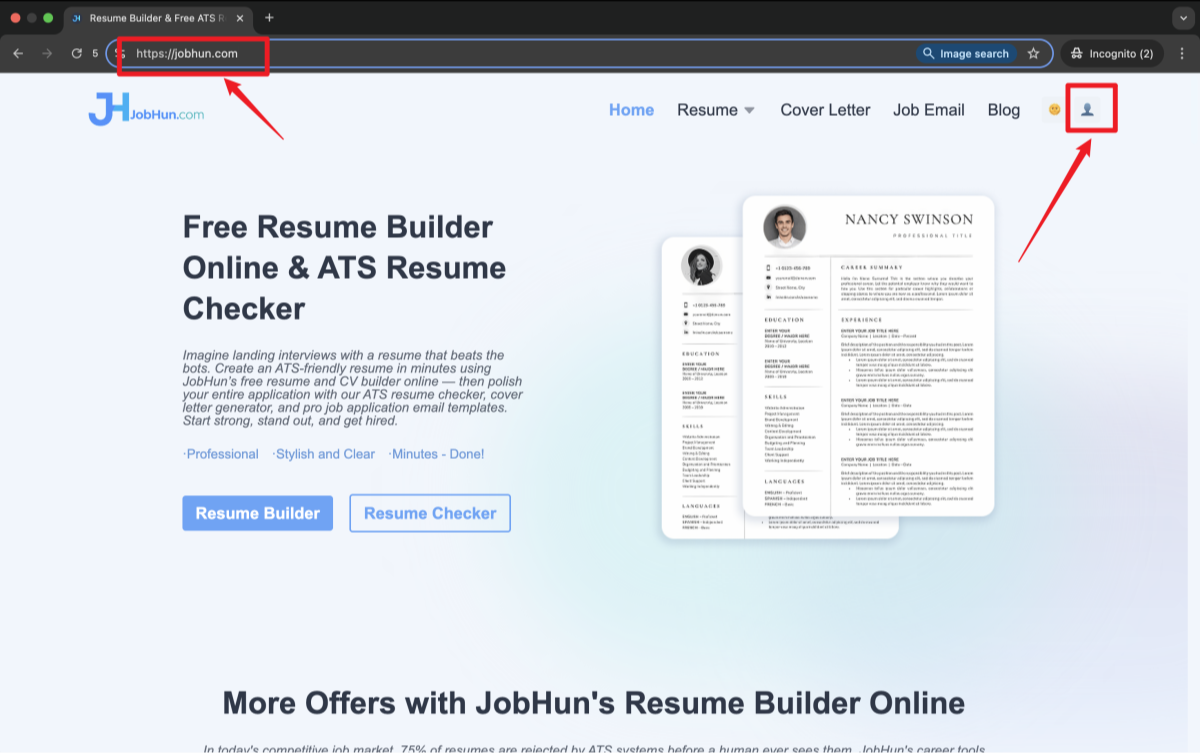
Find Your Way to the Dashboard
You’ll land on the webapp page of JobHun.
Not signed in yet? No worries—you’ll get a prompt.
Click either the “New Resume” button or the “Go to Login” link up top. Both will get you to the sign-in page.
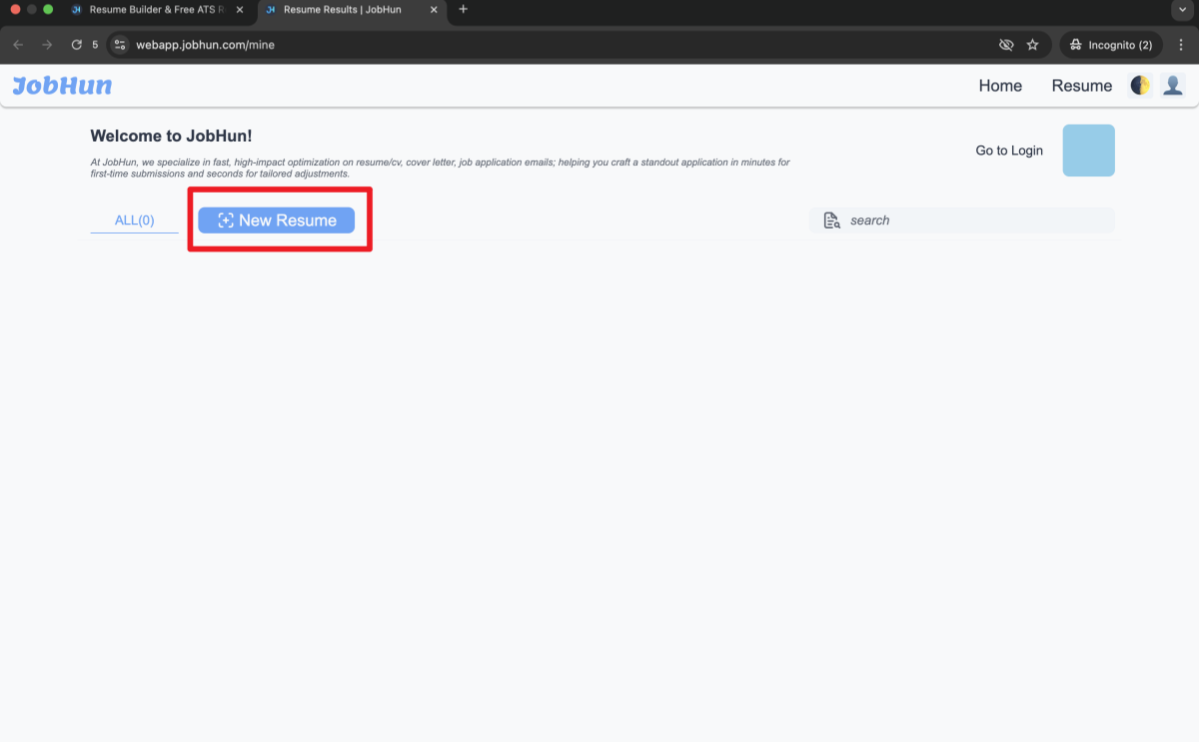
Sign In and Set Up
You’ve got two ways to get in:
- Use Google login to skip the hassle
- Or enter your name, email, and password manually, then hit “Go”
Once you're in, you’ll see your dashboard with all your details.
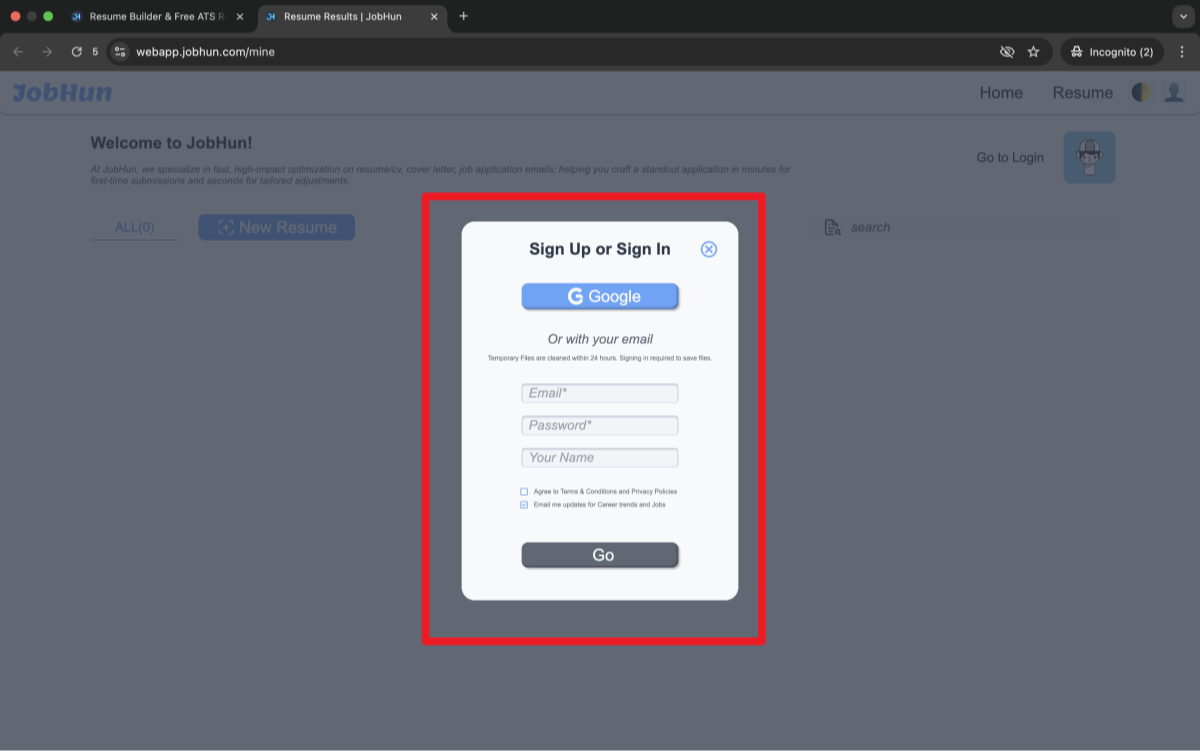
Time to Create a Resume
See your profile in the upper-right? That means you’re in.
Click “New Resume” one more time, and you’re inside the builder.
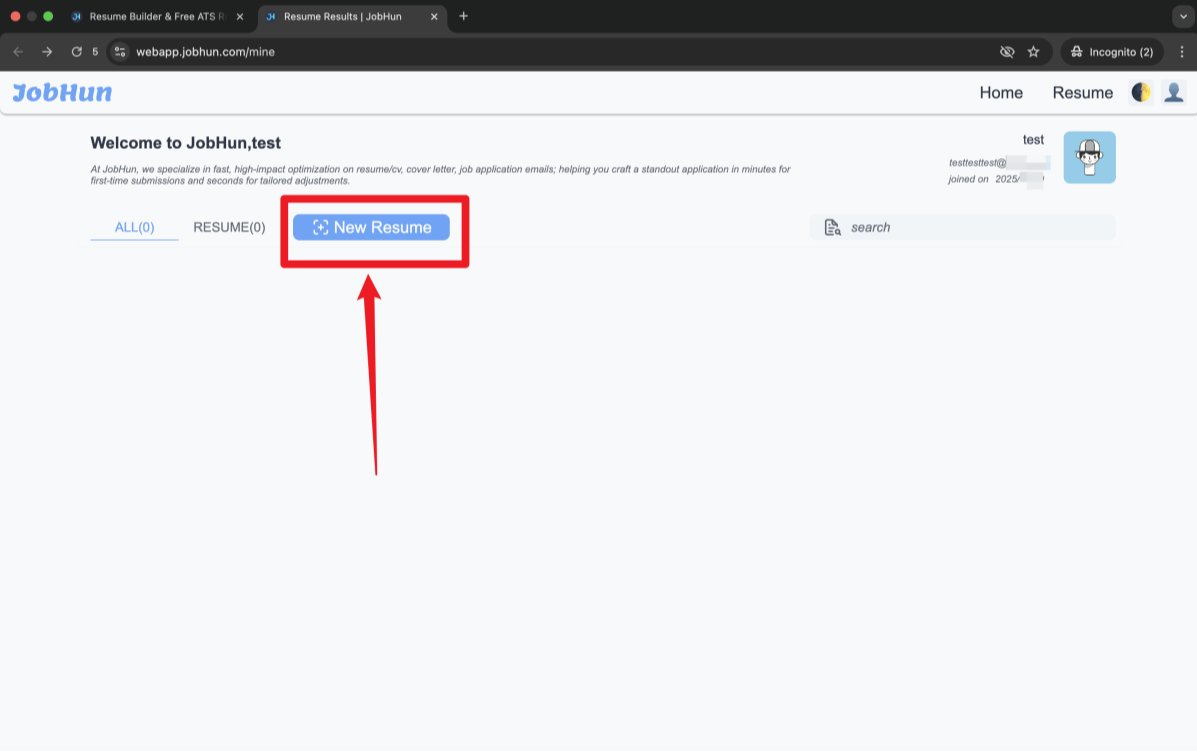
Shape Your Resume Your Way
The builder has two sides:
- On the left: All your editing tools—add experience, reorder sections, update your skills
- On the right: A live preview of your changes
Now you can:
- ✅ Use AI to fill in content
- ✅ Manually refine every detail
- ✅ Customize until it feels just right
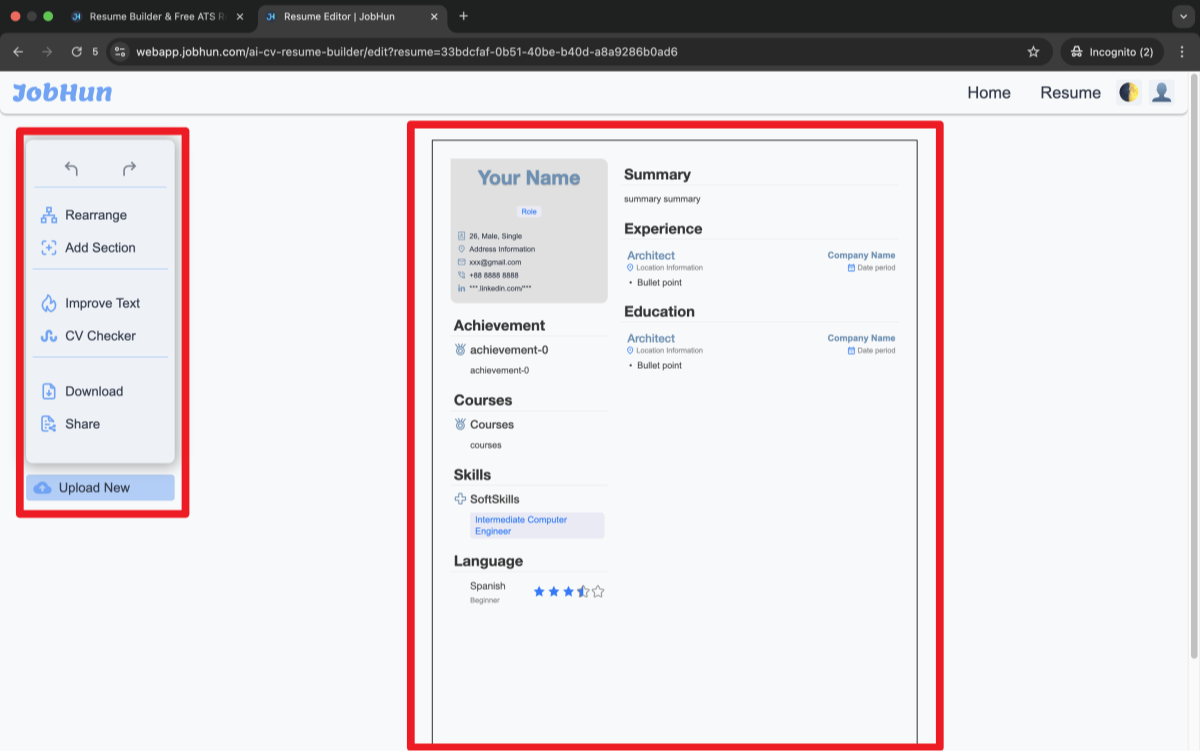
Final Thoughts
Crafting a resume for a career change is about telling a story of growth and adaptability. By choosing the right format, highlighting transferable skills, and tailoring your resume to each job, you can show employers you’re not just starting over—you’re bringing a unique blend of experience and enthusiasm to the table. Pair it with a heartfelt cover letter, and you’ll be ready to take on your new career with confidence.
Crafting a resume for a career change is about telling a story of growth and adaptability. By choosing the right format, highlighting transferable skills, and tailoring your resume to each job, you can show employers you're not just starting over—you're bringing a unique blend of experience and enthusiasm to the table.
Ready to get started? Grab a job description, identify your transferable skills, and start shaping your story today!




![80+ Resume Summary Examples for 2025 [+How-to Guide] | JobHun](https://static.jobhun.com/jobhun/cms/prod/f_1750407838_1364.png?x-oss-process=image/resize,w_800/format,jpg/quality,q_75/auto-orient,1)
